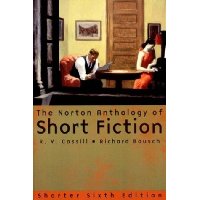The Norton Anthology of Short Fiction
| 商家名称 |
信用等级 |
购买信息 |
订购本书 |
|
|
 |
The Norton Anthology of Short Fiction |
 |
|
 |
The Norton Anthology of Short Fiction |
 |

基本信息·出版社:W. W. Norton & Company; 6 edition
·页码:1030 页
·出版日期:2000年02月
·ISBN:0393975096
·条形码:9780393975093
·装帧:平装
·外文书名:诺顿短篇小说选集 缩写本 第6版
内容简介 This 6th edition features 16 commentaries written for the anthology by contemporary writer, to provide students with a sense of how fiction writers read their contemporaries and the classics. The "Writers on Writing" section features 21 brief interviews and essays that illuminate the practice of writing fiction. Two pieces are new to this section: Gail Godwin on "Becoming a Writer," and an interview with Doris Lessing. Contemporary writing (1980 and after) is represented 17 contemporary stories, 11 of them new, out of the 62 stories. The section on "Talking About Fiction" provides students with a brief introduction to the formal qualities of short fiction. "General Questions" in the introduction help students prepare themselves to respond to the stories they read. "Writing Papers About Fiction," by Richard Bausch, refers back to "Talking About Fiction" and "General Questions" and helps students "formulate a critical response and express it in a paper." "When You Write About Fiction" outlines the different levels of critical writing about fiction, from "personal engagement" to "critical concentration." "Writing Fiction" should be useful in creative writing courses, or in courses in which creative, as well as critical, responses are required.
媒体推荐 书评
Synopsis This 6th edition features 16 commentaries written for the anthology by contemporary writer, to provide students with a sense of how fiction writers read their contemporaries and the classics. The "Writers on Writing" section features 21 brief interviews and essays that illuminate the practice of writing fiction. Two pieces are new to this section: Gail Godwin on "Becoming a Writer," and an interview with Doris Lessing. Contemporary writing (1980 and after) is represented 17 contemporary stories, 11 of them new, out of the 62 stories. The section on "Talking About Fiction" provides students with a brief introduction to the formal qualities of short fiction. "General Questions" in the introduction help students prepare themselves to respond to the stories they read. "Writing Papers About Fiction," by Richard Bausch, refers back to "Talking About Fiction" and "General Questions" and helps students "formulate a critical response and express it in a paper." "When You Write About Fiction" outlines the different levels of critical writing about fiction, from "personal engagement" to "critical concentration." "Writing Fiction" should be useful in creative writing courses, or in courses in which creative, as well as critical, responses are required.




